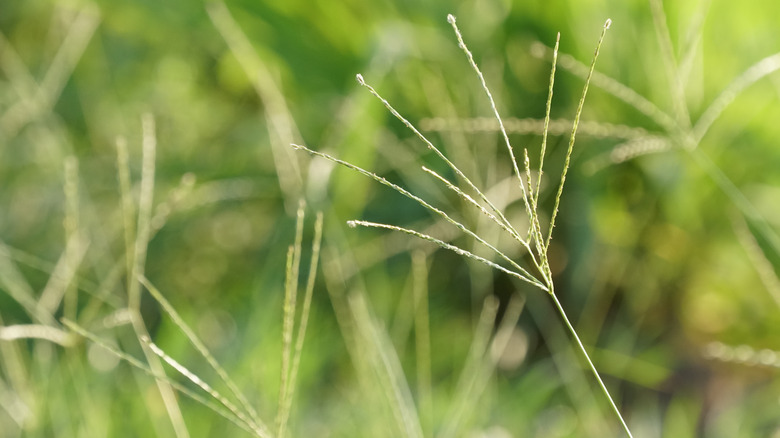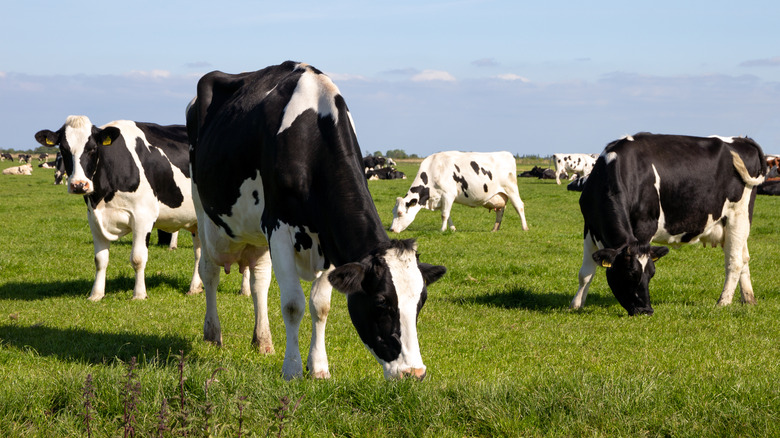Weeds and unwanted, overgrown vegetation can detract from the natural beauty of your yard, and even the most beautiful and well-managed lawns are not safe from the inevitable realities of these invaders trying to destroy your hard work. Digitaria, in particular, commonly known as crabgrass, is one of the most invasive and stubborn varieties of weeds. It can quickly take over and kill your grass if not appropriately controlled, ruining your lawn. Originally native to Europe and Eurasia, per the University of Massachusetts Amherst, crabgrass is now found worldwide in all types of landscape situations, making it challenging to get rid of, as it does well everywhere.
According to Home Depot, crabgrass is not only unsightly, as it contrasts your tamed lawn, but also starves it of the vital nutrients it needs for your grass to grow and thrive. This is one of the top reasons why getting rid of it immediately is essential before your lawn has a chance to suffer. Though crabgrass is stubborn and tricky to manage, early intervention and following the recommended steps for extermination and management can keep your lawn looking beautiful and healthy all summer.
How to identify crabgrass

Crabgrass is easy to identify if you know what you’re looking for. The University of Massachusetts Amherst (UMass Amherst) describes the invasive grass as coarse, yellowish-green grass, which is especially noticeable among the manicured, darker-colored, green blades of grass on your lawn. The Chicago Tribune adds that crabgrass can also be easily identified by its wide leaf blades that have spikes split into groups of threes, resembling the foot of a turkey.
Because crabgrass is considered a summer annual, UMass Amherst says it thrives during the hottest and driest times of summer, when your lawn is weakest and most susceptible to aridness and invasions. This is why the Chicago Tribune notes that crabgrass is commonly found in the most frequently impacted areas of a lawn, such as the grassy area along the driveway that is subject to accidental tire damage. Crabgrass is one weed, in particular, that takes advantage of these delicate areas to choke out the grass on your lawn. The University of Maryland adds that even mowing your lawn too short can weaken the grass enough to make it susceptible to being overtaken by crabgrass.
What are the different types of crabgrass?
The Crabgrass Lawn notes that over 35 known species of crabgrass are found worldwide, and most of the varieties in the United States belong to the families of Digitaria sanguinalis and Digitaria ischaemum. The former comprises the long crabgrass or hairy crabgrass, and the latter is widely referred to as short crabgrass or smooth crabgrass. Both types of Digitaria thrive in most lawn or landscape situations in the summer months — though long crabgrass seems to do particularly well in environments with rich clay or sandy soil.
Long crabgrass can grow to be an average of 1 to 3 feet tall and has finger-esque arrangements of spikes in patterns ranging from 2 to 15 per cluster. According to the Crabgrass Lawn, its leaves average 2 to 3 inches wide and can grow up to 10 inches long. If it weren’t evident from its name, short crabgrass is shorter than its counterpart and only grows to be about 6 inches tall. It also has much broader and smoother stems than those belonging to the long crabgrass family.
How does crabgrass spread?
Christian Delbert/Shutterstock
According to The University of Massachusetts Amherst (UMass Amherst), crabgrass spreads primarily through seed germination, explaining why it is often difficult to control. Because crabgrass plants grow so many branches, anywhere from 150 to 700 at a time, a lone plant can produce as many as 150,000 seeds that can quickly germinate, perpetuating your crabgrass problem.
Once the seeds of a crabgrass plant spread, they remain dormant until it is warm enough for the temperature of the soil to reach 55°F for at least four consecutive days, per UMass Amherst. Under these specific conditions, it will begin to germinate — which is why it grows best from early spring to late summer in most areas where these temperatures are typical. Once crabgrass begins to grow, it will continue for the remainder of the summer until the days start getting shorter again in the fall. And even though frost kills these invasive plants, the Chicago Tribune notes that the seeds they produced and deposited into the soil during that summer can remain viable for many years.
How to prevent crabgrass from growing
Fajar Tri Amboro/Shutterstock
The easiest way to deal with crabgrass in your lawn is to prevent it from growing in the first place, which fortunately is entirely possible with the proper care and precautions since it all comes down to limiting seed production. But because the seeds from a crabgrass plant can remain viable in the soil for several years, The University of Massachusetts Amherst (UMass Amherst) says it’s impossible to control an active crabgrass outbreak in a single growing season. Though this plant can pop up anywhere and is commonly found in most types of landscaping, UMass Amherst says it thrives most easily in lawns, likely because of how frequently they tend to be mowed.
Not only will mowing a lawn too short create a favorable environment for crabgrass plants to take over but moving over them can quickly spread the seeds. To prevent a crabgrass infestation, UMass Amherst recommends keeping the grass in your yard thick and healthy by not mowing it any shorter than 2 inches. The taller grass will be more likely to fend off invading crabgrass, and the longer blades will keep the soil cool enough to prevent seed germination. They also recommend avoiding summer fertilization in your lawn altogether to avoid risking any of the crabgrass plants from benefiting.
How to kill crabgrass
ZikG/Shutterstock
Traditional weed removal by hand or with a small tool is ideal for removing crabgrass roots. These methods are typically effective in the early stages of an infestation, per the University of Maryland. Chemical herbicides can also be effective in killing crabgrass, but timing the application is vital, as varied usage limits the herbicides’ effectiveness unless utilized at the right time during the season. While there are pre and post-emergent herbicides, the former is best for preventing crabgrass outbreaks on a larger scale. They should be applied before seed germination — or, in other words, before the temperature consistently reaches 55°F.
The University of Maryland also adds that most of these herbicides require you to water after the application, so it’s essential to read the label to determine the instructions. A good rule of thumb for deciding when to apply pre-emergent herbicide to your crabgrass is to pay attention to when forsythia plants are blooming and apply the herbicide right then. According to the University of Maryland, post-emergent herbicides are best for spot-treating crabgrass plants, but they are not ideal for eliminating an entire infestation or a lawn overrun with crabgrass.
Are there any benefits to crabgrass?

VanderWolf Images/Shutterstock
Because of its reputation among gardeners everywhere as an infamous and stubborn weed, it might be difficult to believe that there are benefits to having crabgrass around under the right conditions. HowStuffWorks reports that the hearty and relentless nature of crabgrass, traits that many homeowners despise, makes it so worthwhile and valuable to those who benefit from it the most: livestock and farm animals.
Cows, horses, and sheep often rely on the tasty treat for nutrients, which is especially important for animals living in areas with poor growing conditions. Because crabgrass can thrive in all environments and quickly grow to become healthy in soil considered too barren for most other plants, farm animals and other livestock in many parts of the country depend on it for nourishment. The University of Florida reports that not only do they munch on the weed for survival, but they enjoy the taste!


